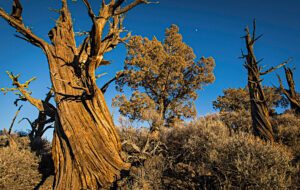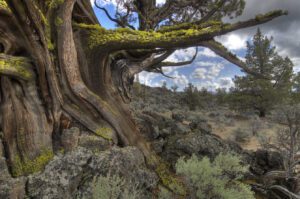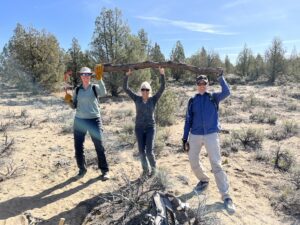Author: Gena Goodman-Campbell | Published: September 26, 2023 | Category: Species Spotlight
This article originally appeared in The Source on September 20, 2023.
Both iconic and beloved in Oregon’s high desert, western juniper is a fascinating, hardy species with a dual nature
“Are juniper trees native or invasive?”
Over the course of my 16-year career working to protect and restore Oregon’s high desert, this is by far the question I am asked the most. And the answer is… both.
Western juniper is a native species that exists most extensively in Oregon and northern California, with smaller populations in Nevada, Idaho and southern Washington. In Oregon, western juniper is found mostly in the high desert — areas with an elevation of 2,000-5,000 feet and a rainfall range of 9-14 inches per year. These gnarled, twisty juniper trees are emblematic of the high desert and play a key role in the ecosystem. They provide shelter for species such as mule deer and both nesting habitat and food for many species of birds, which can be observed gorging on juniper berries during the lean winter months.
Both iconic and beloved in Oregon’s high desert, western juniper is a fascinating, hardy species that can live to be thousands of years old. However, old-growth junipers are relatively rare. The vast majority of juniper trees found in central and eastern Oregon are under 100 years old, having sprouted during the last century when western juniper rapidly expanded their range due to human-caused land disturbances, fire suppression, the changing climate and other factors.

Some of the very characteristics that make juniper hardy survivors – living for thousands of years in some places – are the same factors that make them an invasive species in others. Not only do juniper trees outcompete native grasses and shrubs of the sagebrush steppe by intercepting sunlight and rain before it reaches smaller plants, but they actually excrete chemicals that act as a natural herbicide, killing or stunting the growth of other plants around them. And while juniper trees are naturally drought resistant, they possess both shallow lateral roots and deep taproots to suck up an enormous amount of water when it is available. Juniper expansion is disrupting the delicate balance of life in the desert by crowding out other native plants that treasured wildlife depend upon to survive.
Identifying Ancient Juniper Trees
You might be wondering, “How do I know if this is an ancient tree or an invasive tree?” Telling the difference is relatively straightforward. Though similar in height, old-growth juniper trees are easy to distinguish from young, invasive trees. The revered ancient junipers can be spotted by their rounded, twisting, asymmetrical shapes whereas young junipers are symmetrical and cone-shaped. Old-growth juniper has a beautiful reddish, furrowed bark with profuse florescent green lichen that cover their branches. These durable, perfectly adapted trees are even often found growing improbably in the middle of lava formations, an ability that has helped further their longevity by making them naturally fire resistant.

Located just 15 miles east of Bend, the Oregon Badlands Wilderness is a prime example of old-growth juniper woodland habitat where you’ll find some of the oldest trees in the state. In fact, the oldest known tree in Oregon is a juniper located just south of the Badlands where it has been growing for over 1,600 years.
The presence of both ancient juniper trees in need of protection and invasive junipers that are disrupting the balance of life in the desert means thoughtful, targeted conservation and restoration tactics must be deployed in Oregon’s high desert to ensure the health and vitality of our wildlands, waters and wildlife.
Addressing Invasive Juniper
All across high desert landscapes in central and eastern Oregon, junipers have expanded into grasslands, aspen stands and wet areas along streams and rivers, crowding out native plants and reducing stream flows. Removing invasive trees from areas around springs and streams can increase the amount of water available to support native fish and wildlife, increase the diversity of native vegetation and bring the ecosystem back into balance.

Starting this fall, Oregon Natural Desert Association is leading volunteer projects to remove invasive juniper along small spring-fed streams in the Pine Creek Conservation Area, a conservation property in the John Day River Basin owned by the Confederated Tribes of Warm Springs. Volunteers will cut down small, invasive juniper, and these trees will then be reused to build in-stream structures that will slow the stream flow. As a result, more water can soak into the surrounding soil, dramatically improving habitat conditions and giving other streamside plants a chance to thrive. Juniper cutting and in-stream placement will set us up to have the water needed for future years when ONDA will plant more of the streamside trees and shrubs that help shade and cool the stream, such as willows, wild rose and chokecherry. These tree types also provide important food sources for wildlife and are culturally important plants for members of the Confederated Tribes of Warm Springs.
Whenever I come across an ancient juniper in my travels, I’m struck anew by awe and wonder at the enduring strength of juniper trees. And, I’m grateful to be part of a community of people who care about the well-being of our natural desert environment. I encourage everyone who is curious about the desert to join ONDA on a work trip and spend a little time caring for this endlessly intriguing landscape.
—Gena Goodman-Campbell is the stewardship director at Oregon Natural Desert Association, a nonprofit organization that protects and restores Oregon’s high desert public lands and waters. Goodman-Campbell engages ONDA’s community in hands-on restoration projects that improve desert habitat in key watersheds and migration corridors.


